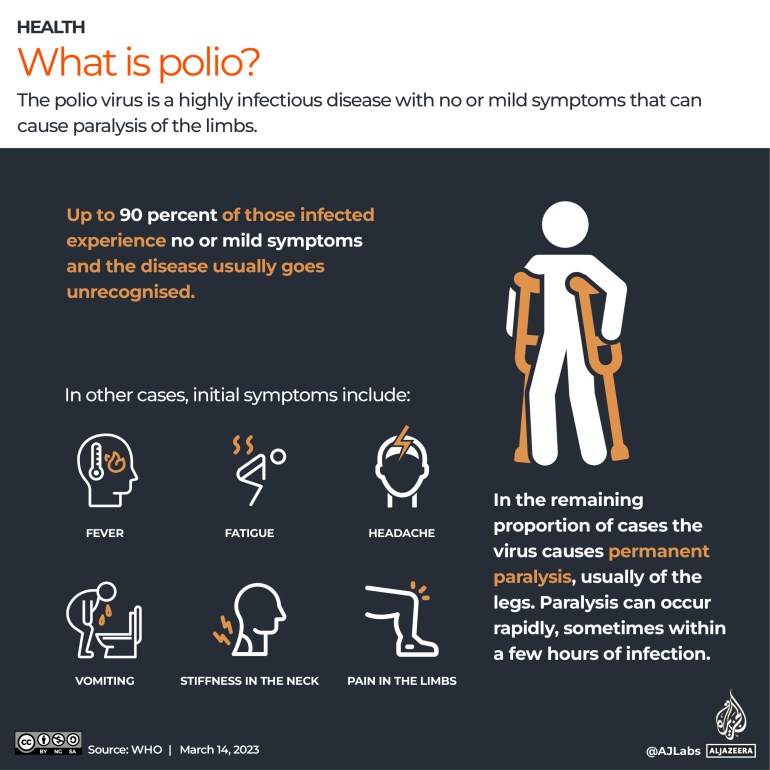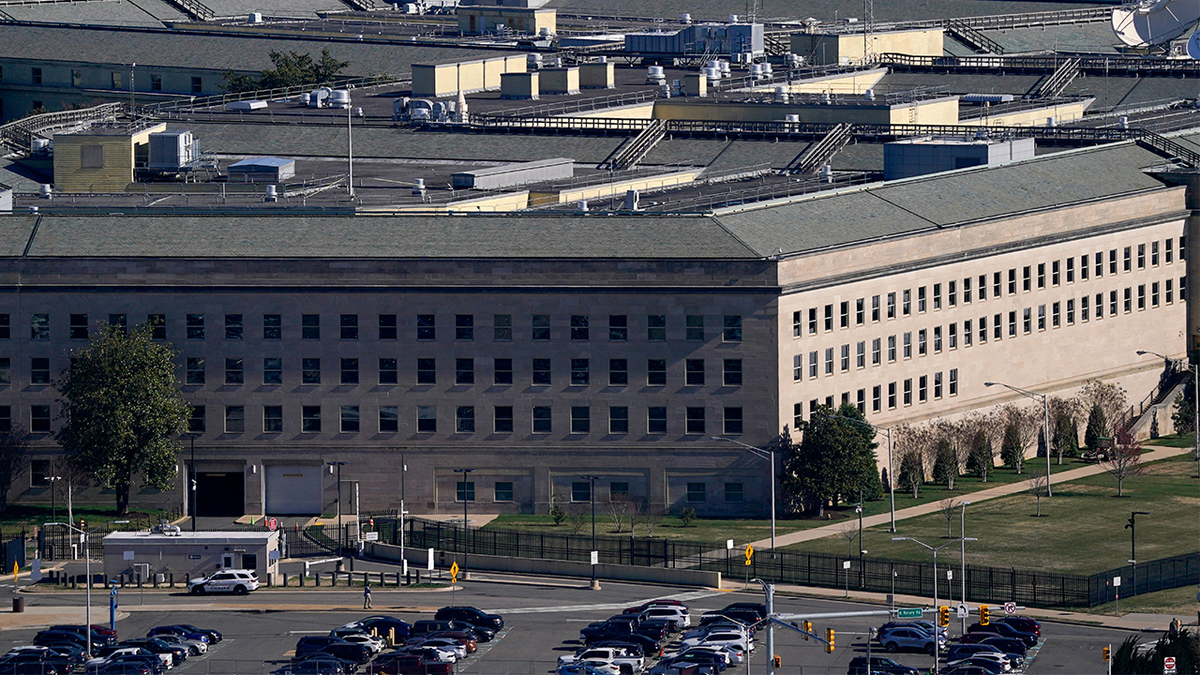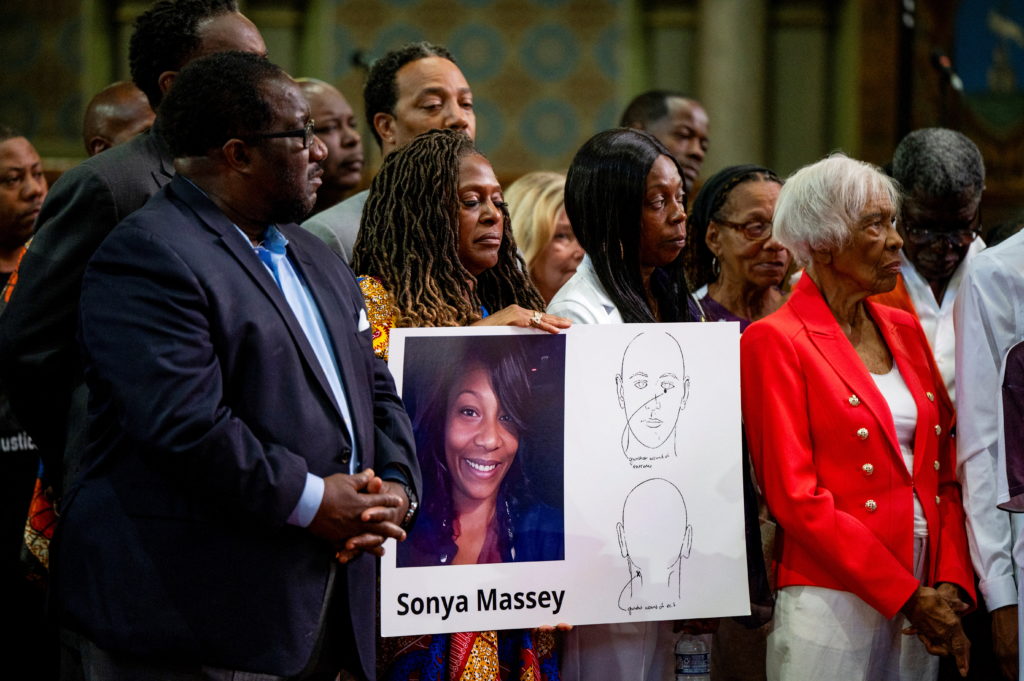World
Will Pakistan ever be able to eradicate polio?

Health workers have begun a campaign to vaccinate 9.5 million children against polio in 41 districts in Pakistan this week. This latest round of a national vaccination drive will include Islamabad and focus particularly on areas where polio-positive sewage samples have been found.
The anti-polio drive will be launched in 16 districts of Balochistan, 11 districts of Khyber Pakhtunkhwa, eight districts of Sindh, and five districts of Punjab, according to local media.
Despite major efforts to eradicate the disease in Pakistan, six cases of the highly infectious virus have already been reported this year. Further hampering the drive, vaccination teams and medical professionals have faced harassment and even physical attacks in some parts of Pakistan.
Pakistan’s PM Shehbaz Sharif, however, said the government “remains steadfast” in its aim to eradicate polio after a meeting with American billionaire philanthropist Bill Gates in Islamabad last week.
How serious a problem is polio in Pakistan?
Pakistan is one of only two countries in the world where polio is still endemic, the other being neighbouring Afghanistan, according to the World Health Organization (WHO).
The highly contagious viral disease largely affects children under the age of five. Children infected by poliovirus can suffer paralysis and in some cases death.
The South Asian nation launched a vaccination programme as part of its Polio Eradication Programme in 1994. Officials say the country used to report more than 20,000 cases annually.
Despite administering more than 300 million doses of the oral vaccine annually and spending billions of dollars, the disease is still rife across Pakistan.
This year, four vaccination campaigns targeting more than 43 million children have already been undertaken as authorities claim they are in the “last mile” of their fight against polio in the country of 235 million people.
How many cases have been reported in Pakistan?
Since 2015, Pakistan has reported 357 polio cases, including six this year. One of the victims, a two-year-old boy, died in May.
Officials said all of this year’s cases belong to the YB3A cluster, which they said originated in Afghanistan, where four cases have been reported this year.
In addition to human cases, wild poliovirus type 1 (WPV1) has frequently been detected in environmental samples taken across the country. This year, WPV1 has been found in 45 of Pakistan’s 166 districts.
How does Pakistan run its polio immunisation campaigns?
Nationwide immunisation campaigns involving more than 350,000 health workers are run in phases with vaccine desks set up at health centres and health workers going door to door. The campaigns are organised by the government-run National Emergencies Operation Center (NEOC), which has been tasked with running Pakistan’s Polio Eradication Programme.
Field workers go door to door over the course of a specified number of days, vaccinating children under the age of five.
Vaccines are also administered at land and air borders, including to adults, and on motorways connecting major cities across the country.
What are the issues facing the polio campaign?
Resistance to the polio immunisation drive grew in Pakistan after the CIA, a United States spy agency, organised a fake hepatitis vaccination drive to track al-Qaeda leader Osama bin Laden, who was killed in 2011 in Pakistan by US special forces.
Misinformation linked to religious beliefs has also been spread, claiming that the vaccine contains traces of pork and alcohol, which are forbidden in Islam.
Disinformation, agenda-driven campaigns, myths, community boycotts and mistrust in the government have also been factors behind refusals. But officials said government campaigns are helping change bad perceptions.
Health authorities in Pakistan have listed seven districts where polio is “endemic”. All seven are in the northwest, in Khyber-Pakhtunkhwa province. Officials said the security situation has been the biggest obstacle in reaching the target population in the province bordering Afghanistan.
In addition to the security situation, health officials say a target population that moves from one place to another, which may be carrying the YB3A variant, has proven to be a challenge.

Why have health workers and security officials been targeted?
Health workers and security officials accompanying them have been harassed, ridiculed, taunted, threatened and even targeted physically.
At least 102 polio field workers, officials and security personnel have been killed, including at least six in campaigns carried out this year.
In recent years, the Pakistan Taliban has killed dozens of health workers and members of the security forces involved in polio campaigns. But officials believe the reason for the violence is not the polio programme alone.
“Over the last few years, it is not the polio programme that is targeted, but unfortunately, the targets are the security personnel guarding the teams because, given the security situation in some parts of the country, they become soft targets when they are in the community,” Dr Hamid Jafari, the WHO’s director of polio eradication, told Al Jazeera.
What other issues affect the health workers?
Low pay, salary delays, lack of assistance and compassion, and tough working conditions are some of the other issues facing the field workers.
Some health workers told Al Jazeera they get paid as little as 1,360 rupees per day (about $5) for at least eight hours of work. Catch-up days when they go out in the field after the end of the campaign to vaccinate children who were missed are not paid, they said.
In addition, some polio survivors now working on the campaign do not receive help with transport or health benefits despite their conditions, leaving them to walk in poor weather and tough terrain to carry out their work.
Some staff lamented the lack of pay parity, saying people working with international organisations involved in the campaign are paid much more.

What is the outlook for the polio eradication campaign?
Dr Shahzad Baig, who was the NEOC chief until May, told Al Jazeera that the aim was to make Pakistan polio-free by 2026.
“That is our target at the moment,” he said before he was replaced.
However, after a Technical Advisory Group meeting organised by the WHO that took place in Qatar in May, there are increasing concerns over the “deteriorating situation of the disease” in the country, according to a report by Pakistan’s Dawn newspaper.
A Pakistani official quoted in the report said that at the meeting, “We faced an embarrassing situation as all the gains made by Pakistan in 2021 have been lost and the virus has re-emerged in three blocks.”
Health officials, however, remain hopeful, given that the number of positive cases has decreased significantly over the past five years – from 147 in 2019 to six so far this year.
“The programmes in Pakistan and Afghanistan are very mature and have learned a lot,” Jafari said.
“Despite changes in government and security situations, these programmes have evolved, adapted and adjusted. And that’s why they have a level of population immunity that you’re not seeing outbreaks of paralytic polio cases.
“It’s not a widespread problem across Pakistan. It’s not even a widespread geographic problem. It is now a matter of getting to these final, hard-to-reach populations. When you start reaching these populations, progress happens very fast.”


World
Colin Farrell Says Tom Cruise ‘Was Not Happy’ on ‘Minority Report’ Set After Farrell Drank Before Filming and Needed to Do 46 Takes of One Scene: ‘It Went Terrible’

Colin Farrell revealed to Stephen Colbert on “The Late Show” that Tom Cruise “was not happy” with him during the making of Steven Spielberg’s “Minority Report.” Farrell was in the midst of his substance abuse struggles during production and went out partying the night before his birthday, which happened to be a filming day.
“I had one of the worst days I’ve ever had on a film set [on ‘Minority Report’],” Farrell admitted. “It was my birthday on May 31, and we were shooting, and I begged production — who did I think I was? — of a $120 million film if they [could] not have me working on my birthday. So of course my pickup was 6 a.m. on May 31, and I got up to all sorts of nonsense the night before. And I remember getting into bed, and as soon as I turned off the light the phone rang and it was the driver, [who] said, ‘It’s 10 past 6.’ And I went, ‘Oh, shit.’”
Farrell was disheveled when he showed up on the “Minority Report” set, so much so that assistant director David H. Venghaus Jr. stopped him and said: “You can’t go to the set like this.’”
“And I went, ‘Just get me six Pacifico Cervezas and a packet of 20 [Marlboro] Red,’” Farrell said. “Now, listen, it’s not cool because two years later I went to rehab, right? But it worked in the moment. All the holy people that we look to on how to live a life would say the present is all that counts.”
Farrell “had a couple of beers” and went to set and “it was terrible,” he said. “I will never forget the line I had that I couldn’t get out. It was, ‘I’m sure you’ve all grasped the fundamental paradox of pre-crime methodology.’ That was the line that started the scene. I remember [the crew] coming up and saying, ‘Do you want to go out and take a breath of fresh air?’ And I remember thinking, ‘If I go out and take a breath of fresh air, then I’ll be under more pressure when I come back in to be better.’ And I went, ‘No, we’ll just go through it.’”
“We did 46 takes,” Farrell revealed. “Tom wasn’t very happy with me. Tom, who I love, was not very happy!”
Loosely based on Philip K. Dick’s 1956 novella, “Minority Report” is set in a future where police apprehend criminals by using psychics who give them foreknowledge of the impending crime. Cruise’s police chief is framed for a crime he did not commit, forcing him on the run. Farrell plays the police agent assigned with bringing Cruise’s character in. The movie was a critical favorite and grossed a strong $358 million worldwide.
Watch Farrell’s full interview on “The Late Show” in the video below.
World
Hegseth says military conducted another strike on boat carrying alleged narco-terrorists

NEWYou can now listen to Fox News articles!
Pentagon chief Pete Hegseth announced the U.S. military on Wednesday struck another boat carrying people he claims were narco-terrorists.
The strikes were carried out in the Eastern Pacific region at the direction of President Donald Trump, killing four men on board, according to Hegseth.
The military “carried out a lethal kinetic strike on yet another narco-trafficking vessel operated by a Designated Terrorist Organization (DTO) in the Eastern Pacific,” Hegseth wrote on X.
“This vessel, like all the others, was known by our intelligence to be involved in illicit narcotics smuggling, was transiting along a known narco-trafficking route, and carrying narcotics,” he said. “Four male narco-terrorists were aboard the vessel — and killed — during the strike, which was conducted in international waters. No U.S. forces were harmed in this strike.”
US STRIKES ANOTHER ALLEGED DRUG-TRAFFICKING BOAT NEAR VENEZUELA, KILLING 4
(Secretary of War Pete Hegseth via X)
“The Western Hemisphere is no longer a safe haven for narco-terrorists bringing drugs to our shores to poison Americans,” Hegseth added. “The Department of War will continue to hunt them down and eliminate them wherever they operate.”
This is the 14th strike on suspected drug boats carried out since September. A total of 61 have reportedly been killed while three survived, including at least two who were later repatriated to their home countries.
The Pentagon has refused to release the identities of those killed or evidence of drugs on board.
US DEPLOYS FORD CARRIER STRIKE GROUP TO COMBAT NARCO-TERROR IN WESTERN HEMISPHERE

Pentagon chief Pete Hegseth announced the U.S. military struck another boat carrying who he claims were narco-terrorists. (Kevin Lamarque/Reuters)
The Trump administration has been scrutinized in recent weeks over the strikes, including by Sen. Rand Paul, R-Ky., who raised concerns about killing people without due process and the possibility of killing innocent people.
Paul has cited Coast Guard statistics that show a significant percentage of boats boarded for suspicion of drug trafficking are innocent.
The senator has also argued that if the administration plans to engage in a war with Venezuela after it has targeted boats it claims are transporting drugs for the Venezuela-linked Tren de Aragua gang, it must seek a declaration of war from Congress.

The Pentagon has refused to release the identities of those killed or evidence of drugs on board. (Reuters)
CLICK HERE TO DOWNLOAD THE FOX NEWS APP
Democrats on the Senate Judiciary Committee also penned a letter Wednesday demanding to review the legal justification behind the series of boat strikes they say appear to violate several laws.
“Drug trafficking is a terrible crime that has had devastating impacts on American families and communities and should be prosecuted. Nonetheless, the President’s actions to hold alleged drug traffickers accountable must still conform with the law,” the letter states.
World
RFK Jr walks back Trump administration’s claims linking Tylenol and autism

Kennedy, a top health official, urges ‘cautious approach’ after Trump baselessly claimed taking Tylenol is linked autism in children.
United States Health and Human Services Secretary Robert F Kennedy Jr has partially walked back his warning that taking Tylenol during pregnancy is directly linked to autism in children.
In a news conference on Wednesday, Kennedy struck a more moderate tone than he generally has in his past public appearances.
list of 3 itemsend of listRecommended Stories
“The causative association between Tylenol given in pregnancy and the perinatal periods is not sufficient to say it definitely causes autism,” Kennedy told reporters. “But it’s very suggestive.”
“There should be a cautious approach to it,” he added. “ That’s why our message to patients, to mothers, to people who are pregnant and to the mothers of young children is: Consult your physician.”
Wednesday’s statement is closer in line with the guidance of reputable health agencies.
While some studies have raised the possibility of a link between Tylenol and autism, there have been no conclusive findings. Pregnant women are advised to consult a doctor before taking the medication.
The World Health Organization reiterated the point in September, noting that “no consistent association has been established” between the medication and autism, despite “extensive research”.
But claims to the contrary have already prompted efforts to limit the availability of Tylenol, a popular brand of acetaminophen, a fever- and pain-reducing medication.
On Tuesday, Texas Attorney General Ken Paxton launched a lawsuit accusing Johnson & Johnson and Kenvue, the companies behind the over-the-counter pain reliever, of deceptive practices.
In doing so, he reiterated misinformation shared by President Donald Trump and government officials like Kennedy.
“By holding Big Pharma accountable for poisoning our people, we will help Make America Healthy Again,” Paxton said in a statement, giving a nod to Kennedy’s MAHA slogan.
The suit alleges that Johnson & Johnson and Kenvue violated Texas consumer protection laws by having “deceptively marketed Tylenol as the only safe painkiller for pregnant women”.
It was the latest instance of scientific misinformation being perpetuated by top officials. Both Trump and Kennedy have repeatedly spread scientific misinformation throughout their political careers.
Trump linked autism and the painkiller during a news conference in September, without providing reputable scientific findings to back the claim.
“[Using] acetaminophen – is that OK? – which is basically, commonly known as Tylenol, during pregnancy can be associated with a very increased risk of autism,” Trump said on September 22. “So taking Tylenol is not good. I’ll say it. It’s not good.”
Kennedy has offered his own sweeping statements about Tylenol and its alleged risks, despite having no professional medical background.
“Anyone who takes this stuff during pregnancy, unless they have to, is irresponsible,” he said in a cabinet meeting on October 9.
Kennedy also mischaracterised studies on male circumcision earlier this month. He falsely said the studies showed an increase in autism among children who were “circumcised early”.
“It’s highly likely because they’re given Tylenol,” he added.
Kenvue stressed in a statement on Tuesday that acetaminophen is the safest pain reliever option for pregnant women, noting that high fevers and pain are potential risks to pregnancies if left untreated.
“We stand firmly with the global medical community that acknowledges the safety of acetaminophen and believe we will continue to be successful in litigation as these claims lack legal merit and scientific support,” Kenvue said.
-

 New York7 days ago
New York7 days agoVideo: How Mamdani Has Evolved in the Mayoral Race
-

 World1 week ago
World1 week agoIsrael continues deadly Gaza truce breaches as US seeks to strengthen deal
-

 News1 week ago
News1 week agoVideo: Federal Agents Detain Man During New York City Raid
-

 News1 week ago
News1 week agoBooks about race and gender to be returned to school libraries on some military bases
-

 Technology1 week ago
Technology1 week agoAI girlfriend apps leak millions of private chats
-

 Politics1 week ago
Politics1 week agoTrump admin on pace to shatter deportation record by end of first year: ‘Just the beginning’
-

 News1 week ago
News1 week agoTrump news at a glance: president can send national guard to Portland, for now
-

 Business1 week ago
Business1 week agoUnionized baristas want Olympics to drop Starbucks as its ‘official coffee partner’


















